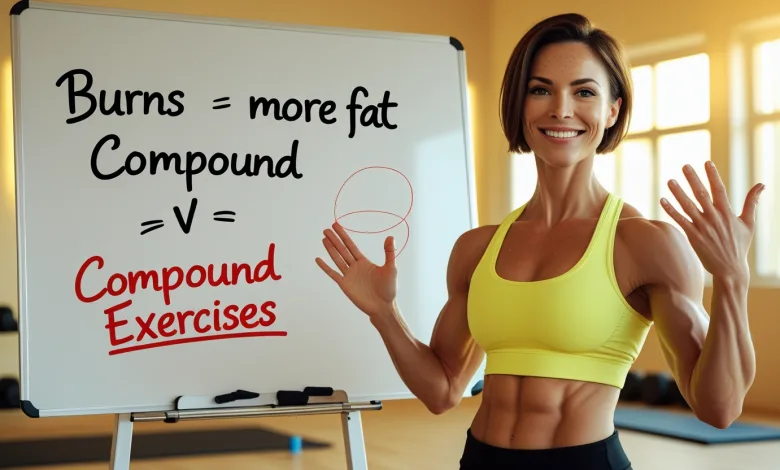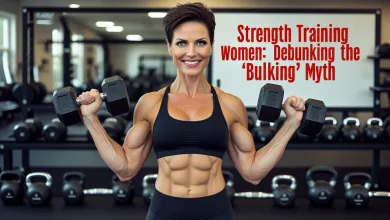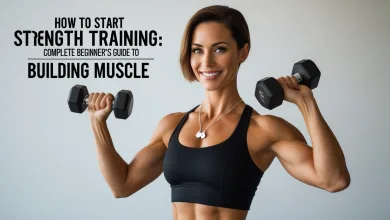Compound vs. Isolation Exercises: Which Burns More Fat?

Confused about whether to focus on compound or isolation exercises for fat loss? This comprehensive guide breaks down the science behind both training methods to help you make informed decisions about your workout routine.
The Battle of Exercise Styles: An Introduction
Let’s face it — when you’re sweating it out at the gym with fat loss in mind, you want to make every minute count. The age-old debate between compound and isolation exercises has left many fitness enthusiasts scratching their heads, wondering which approach will help them shed those stubborn pounds faster. Well, you’re in luck! We’re about to dive deep into this fitness conundrum and help you figure out which exercise style deserves more real estate in your workout routine.
Before we jump in, it’s worth noting that “the best exercise” isn’t necessarily universal — it’s the one you’ll actually do consistently. But hey, that doesn’t mean we can’t optimize your time and effort by understanding the science behind these different training approaches. After all, knowledge is power, especially when it comes to transforming your physique!
Understanding Compound Exercises: The Multi-Joint Marvels
Compound exercises are the heavy hitters of the fitness world — movements that engage multiple muscle groups and joints simultaneously. Think squats, deadlifts, bench presses, pull-ups, and rows. These exercises don’t mess around when it comes to challenging your body.
When you perform a compound movement like a squat, you’re not just working your quadriceps. Oh no! You’re also engaging your glutes, hamstrings, calves, core, and even your upper back to stabilize the weight. This multi-muscle recruitment is precisely what makes compound exercises so darn effective for burning fat.
According to a study published in the Journal of Strength and Conditioning Research, compound exercises lead to greater energy expenditure compared to isolation movements, primarily due to the larger muscle mass involvement. In simpler terms, when more muscles are working, more calories are burning — and that’s music to the ears of anyone looking to shed some extra pounds.
Another compelling advantage of compound exercises is their hormonal impact. Research shows that movements like deadlifts and squats trigger a significant release of growth hormone and testosterone — both critical players in the fat-burning game. These hormonal responses can boost your metabolism for hours after your workout has ended, a phenomenon known as excess post-exercise oxygen consumption (EPOC) or the “afterburn effect.”
Isolation Exercises: The Targeted Approach
On the other side of the ring, we have isolation exercises — movements that primarily focus on a single muscle group and typically involve action at just one joint. Classic examples include bicep curls, tricep extensions, leg extensions, and lateral raises. These exercises are the precision tools in your fitness toolkit.
While isolation exercises might not pack the same caloric punch as their compound counterparts, they certainly have their place in a well-rounded fat loss program. For starters, they allow you to target specific muscle groups that might be lagging or need extra attention. This targeted approach can help address muscle imbalances and enhance overall body symmetry.
Isolation exercises also tend to be less technically demanding than compound movements. This means they’re often easier to learn and perform correctly, making them accessible for beginners or those recovering from injuries. Additionally, they typically cause less central nervous system fatigue, allowing for higher training volumes without excessive recovery demands.
Research published in the International Journal of Exercise Science suggests that isolation exercises can effectively increase regional blood flow to the targeted muscle, potentially enhancing nutrient delivery and waste removal. While this might not directly translate to greater fat burning, it can support muscle growth and recovery — both important factors in long-term body composition improvements.
The Caloric Burn Comparison
Let’s cut to the chase — when it comes to immediate caloric expenditure, compound exercises typically have the edge. A 2017 study in the Journal of Sports Medicine and Physical Fitness compared the energy cost of compound versus isolation exercises and found that multi-joint movements resulted in approximately 25-30% greater calorie burn during the actual workout.
This difference becomes even more pronounced when we factor in the intensity at which these exercises can be performed. With compound movements, you can generally use heavier weights, which translates to greater energy demands. For instance, a heavy set of deadlifts might burn 3-4 times the calories of a set of leg curls, despite both targeting some of the same muscles.
But here’s where things get interesting: the fat-burning equation isn’t just about calories burned during exercise. It’s also about:
- The afterburn effect (EPOC)
- Muscle preservation and growth
- Hormonal responses
- Workout efficiency and sustainability
And when we consider these factors holistically, the picture becomes more nuanced than simply “compound exercises burn more fat.”
The Metabolic Impact: Beyond Immediate Calorie Burn
When it comes to fat loss, we can’t ignore the importance of metabolism — your body’s engine for burning calories. And boy, does exercise selection matter here!
Compound exercises generally stimulate a greater metabolic response than isolation movements. A study in the European Journal of Applied Physiology found that complex, multi-joint exercises resulted in higher post-exercise oxygen consumption compared to single-joint movements, indicating enhanced calorie burning for hours after the workout.
This metabolic advantage stems from several mechanisms:
- Greater muscle damage and repair: More muscles worked means more tissue that needs recovery, which requires energy.
- Hormonal cascade: As mentioned earlier, compound movements trigger more significant releases of anabolic hormones.
- Greater glycogen depletion: Multi-joint exercises deplete more muscle glycogen, requiring more energy during the refilling process.
However, isolation exercises shouldn’t be dismissed entirely from a metabolic perspective. When strategically incorporated into a workout routine, they can help increase overall training volume without excessive fatigue, potentially leading to greater total energy expenditure over time.
Building Muscle: The Secret Weapon for Fat Loss
Here’s something that might seem counterintuitive at first: building muscle is one of the most effective long-term strategies for fat loss. Why? Because muscle tissue is metabolically active, meaning it burns calories even when you’re not exercising. The more muscle you have, the higher your resting metabolic rate.
Both compound and isolation exercises can contribute to muscle growth, but they do so in slightly different ways:
Compound exercises typically allow for heavier loading and stimulate a greater hormonal response, creating an excellent environment for overall muscle development. According to research in the Journal of Applied Physiology, exercises like squats and deadlifts have been shown to increase muscle protein synthesis throughout the entire body, not just in the muscles directly targeted.
Isolation exercises, while not as metabolically demanding, allow for more targeted hypertrophy (muscle growth) in specific areas. This can be particularly valuable for bringing up lagging body parts or addressing aesthetic goals. Research published in the Journal of Strength and Conditioning Research indicates that isolation movements may allow for greater time under tension for individual muscle groups, a key factor in hypertrophy.
For optimal fat loss results, maintaining or building muscle mass should be a priority, and this often requires a strategic combination of both exercise types.
Practical Applications: Creating an Optimal Fat-Burning Workout
So, with all this information in mind, how should you structure your workouts for maximum fat burning? Here’s a practical approach that incorporates the best of both worlds:
Prioritize Compound Movements
Start your workouts with compound exercises when energy levels are highest. These movements should form the foundation of your program, accounting for approximately 60-70% of your total training volume. Key exercises to include:
- Squats (back, front, or goblet variations)
- Deadlifts (conventional, sumo, or Romanian)
- Bench press (barbell or dumbbell)
- Overhead press (standing or seated)
- Pull-ups or lat pulldowns
- Rows (barbell, dumbbell, or cable)
- Lunges (walking, reverse, or Bulgarian split squats)
These movements will drive the majority of your caloric expenditure and hormonal response, creating an ideal environment for fat loss.
Supplement with Strategic Isolation Work
After completing your compound exercises, incorporate isolation movements to:
- Target muscles that need additional work
- Increase overall training volume
- Address muscle imbalances
- Focus on aesthetic goals
Effective isolation exercises include:
- Bicep curls and tricep extensions
- Lateral raises and face pulls
- Leg extensions and leg curls
- Calf raises and wrist curls
- Abdominal isolation exercises
Aim for these to comprise about 30-40% of your total training volume.
Special Considerations for Different Populations
It’s important to recognize that the optimal approach may vary depending on individual circumstances. Let’s explore some special considerations:
For Beginners
If you’re new to resistance training, focusing primarily on compound movements will provide the greatest return on investment. These exercises will:
- Teach fundamental movement patterns
- Develop full-body coordination
- Build a base of strength and muscle
- Maximize caloric expenditure per workout
However, beginners should start with less complex variations (like goblet squats instead of barbell back squats) and gradually progress as technique improves.
For Intermediate and Advanced Lifters
As you gain experience, a more balanced approach becomes beneficial. While compound movements should still form the foundation of your program, strategic isolation work becomes increasingly important for:
- Breaking through plateaus
- Addressing weak points in lifts
- Optimizing body composition
- Preventing injuries from muscular imbalances
Research in the Journal of Sports Science & Medicine suggests that more experienced lifters often benefit from higher training volumes, which may necessitate the inclusion of more isolation work.
For Those With Time Constraints
If time efficiency is your primary concern, emphasizing compound movements is clearly the way to go. A study in the Journal of Strength and Conditioning Research found that a 45-minute workout consisting of solely compound exercises burned significantly more calories than a same-duration workout of isolation movements.
Frequently Asked Questions
Can I lose fat by doing only isolation exercises?
Yes, you can lose fat with isolation-only training, but it’s generally less efficient. Fat loss ultimately depends on creating a caloric deficit, which can be achieved through any type of exercise combined with proper nutrition. However, isolation-only routines typically burn fewer calories per minute and may not stimulate the same beneficial hormonal responses as compound exercises.
How many compound exercises should I do per workout?
For most people, 3-5 compound exercises per workout is optimal. This allows for sufficient stimulus without excessive fatigue. A typical structure might include:
- 1-2 lower body compound movements
- 2-3 upper body compound movements
- 2-4 isolation exercises as accessories
Should I do cardio along with my resistance training for fat loss?
Combining resistance training with cardiovascular exercise can be extremely effective for fat loss. Research published in the Journal of Applied Physiology suggests that the combination leads to greater fat loss than either modality alone. However, the resistance component should include both compound and isolation exercises for optimal results.
Is it better to do isolation or compound exercises first in a workout?
Most research suggests performing compound exercises first when energy and focus are highest. A study in the Journal of Strength and Conditioning Research found that performing isolation exercises before compound movements can significantly reduce performance in the latter. However, if a specific muscle group is a priority for your goals, you might occasionally prioritize isolation work for that area.
Wrapping Things Up: The Verdict on Fat Burning Exercise Selection
As we’ve seen throughout this exploration of compound versus isolation exercises, both types have their place in an effective fat-burning program. However, if we’re forced to crown a winner in this fitness face-off, compound exercises take the trophy for most efficient fat burning potential.
The science clearly shows that multi-joint movements create greater energy expenditure, more significant hormonal responses, and superior metabolic effects compared to isolation exercises. Yet, this doesn’t mean isolation movements should be abandoned entirely. Their targeted approach complements the foundation built by compound exercises, addressing muscle imbalances and aesthetic goals that might otherwise be overlooked.
The most successful approach to fat loss through resistance training likely involves:
- Building your program around challenging compound movements
- Supplementing with strategic isolation exercises
- Progressively overloading both types of exercises over time
- Adjusting the balance based on your experience level, time constraints, and specific goals
Remember that consistency trumps perfection every time. The “perfect” exercise selection performed inconsistently will never outperform a “good enough” program that you stick with religiously. Find the balance of compound and isolation exercises that you enjoy and can maintain long-term, and the results will follow.
By understanding the unique benefits and limitations of both exercise styles, you can craft a training program that maximizes fat burning while building the physique you desire. Now that’s a winning combination!





